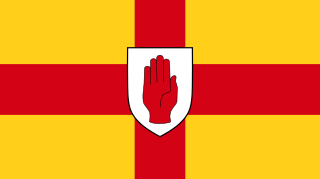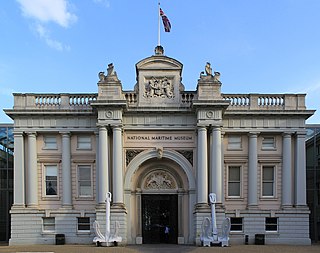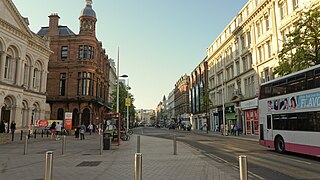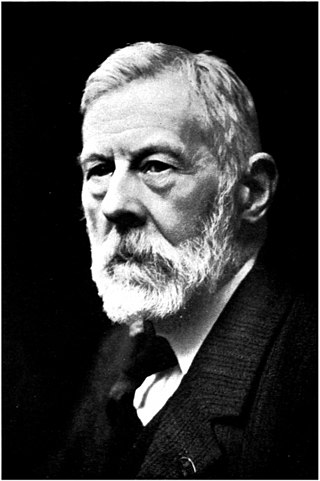Related Research Articles

Belfast is the capital city and principal port of Northern Ireland, standing on the banks of the River Lagan and connected to the open sea through Belfast Lough and the North Channel. It is second to Dublin as the largest city on the island of Ireland with a population in 2021 of 345,418 and a metro area population of 671,559.

Ulster is one of the four traditional or historic Irish provinces. It is made up of nine counties: six of these constitute Northern Ireland ; the remaining three are in the Republic of Ireland.

The National Maritime Museum (NMM) is a maritime museum in Greenwich, London. It is part of Royal Museums Greenwich, a network of museums in the Maritime Greenwich World Heritage Site. Like other publicly funded national museums in the United Kingdom, it has no general admission charge; there are admission charges for most side-gallery temporary exhibitions, usually supplemented by many loaned works from other museums.

Ulster Bank is a large retail bank, and one of the traditional Big Four Irish clearing banks. The Ulster Bank Group was subdivided into two separate legal entities: National Westminster Bank Plc, trading as Ulster Bank ; and, until April 2023, Ulster Bank Ireland DAC. Prior to the closure of Ulster Bank in the Republic of Ireland in April 2023, the headquarters of Ulster Bank in the Republic of Ireland were located on George's Quay, Dublin, whilst the headquarters of Ulster Bank Northern Ireland are in Donegall Square East, Belfast, and it maintains a large sector of the financial services in both the UK and the Republic of Ireland.

The Ulster Museum, located in the Botanic Gardens in Belfast, has around 8,000 square metres of public display space, featuring material from the collections of fine art and applied art, archaeology, ethnography, treasures from the Spanish Armada, local history, numismatics, industrial archaeology, botany, zoology and geology. It is the largest museum in Northern Ireland, and one of the components of National Museums Northern Ireland.
The Public Record Office of Northern Ireland (PRONI) is situated in Belfast, Northern Ireland. It is a division within the Engaged Communities Group of the Department for Communities (DfC).

Belfast Lough is a large sea inlet on the east coast of Northern Ireland. At its head is the city and port of Belfast, which sits at the mouth of the River Lagan. The lough opens into the North Channel and connects Belfast to the Irish Sea.

Both the Ulster Folk Museum and Ulster Transport Museum are situated in Cultra, Northern Ireland, about 11 kilometres (6.8 mi) east of the city of Belfast. Now operating as two separate museums, the Folk Museum endeavours to illustrate the way of life and traditions of the people in Northern Ireland, past and present, while the Transport Museum explores and exhibits methods of transport by land, sea and air, past and present. The museums rank among Ireland's foremost visitor attractions and is a former Irish Museum of the Year. The location houses two of four museums included in National Museums NI.

SS Nomadic is a former tender of the White Star Line, launched on 25 April 1911 at Belfast, that is now on display in Belfast's Titanic Quarter. She was built to transfer passengers and mail to and from the ocean liners RMS Olympic and RMS Titanic. She is the only surviving vessel designed by Thomas Andrews, who also helped design those two ocean liners, and the last White Star Line vessel in existence today.

The Odyssey Complex, consisting of Odyssey Place and the SSE Arena, is a sports, entertainment and science learning complex located within the Titanic Quarter in Belfast, Northern Ireland.

HMS Caroline is a decommissioned C-class light cruiser of the Royal Navy that saw combat service in the First World War and served as an administrative centre in the Second World War. Caroline was launched and commissioned in 1914. At the time of her decommissioning in 2011 she was the second-oldest ship in Royal Navy service, after HMS Victory. She served as a static headquarters and training ship for the Royal Naval Reserve, based in Alexandra Dock, Belfast, Northern Ireland, for the later stages of her career. She was converted into a museum ship. From October 2016 she underwent inspection and repairs to her hull at Harland and Wolff and opened to the public on 1 July 2017 at Alexandra Dock in the Titanic Quarter in Belfast.

The economy of Northern Ireland is the smallest of the four constituents of the United Kingdom and the smaller of the two jurisdictions on the island of Ireland. At the time of the Partition of Ireland in 1922, and for a period afterwards, Northern Ireland had a predominantly industrial economy, most notably in shipbuilding, rope manufacture and textiles, but most heavy industry has since been replaced by services. Northern Ireland's economy has strong links to the economies of the Republic of Ireland and Great Britain.

Robert John Welch was an Irish photographer interested in natural history, particularly mollusca. Welch, born in Strabane, County Tyrone, lived for a time in Enniskillen. He was the son of an accomplished Scottish amateur photographer. After the death of his father, Welch established his own business in 1883 in Lonsdale Street in Belfast. Much of his time was spent taking pictures that reflected the life of the people and the contemporary landscape.

The Belfast to Bangor line is a railway line in Northern Ireland, originally part of the Belfast & County Down Railway. All services are operated by NI Railways, the only operator for Northern Ireland (NI). Unlike the rest of the United Kingdom, no railway in NI is part of the National Rail network and none is owned by Network Rail. Services run every half-hour, with up to six trains per hour in each direction at peak times.

Titanic Quarter in Belfast, Northern Ireland, is a large-scale waterfront regeneration, comprising historic maritime landmarks, film studios, education facilities, apartments, a riverside entertainment district, and the world's largest Titanic-themed attraction centred on land in Belfast Harbour, known until 1995 as Queen's Island. The 185-acre (75 ha) site, previously occupied by part of the Harland and Wolff shipyard, is named after the company's, and the city's, most famous product, RMS Titanic. Titanic Quarter is part of the Dublin-based group, Harcourt Developments, which has held the development rights since 2003.
The culture of Belfast, much like the city, is a microcosm of the culture of Northern Ireland. Hilary McGrady, chief executive of Imagine Belfast, claimed that "Belfast has begun a social, economic and cultural transformation that has the potential to reverberate across Europe." Belfast is split between two rarely-overlapping vibrant cultural communities, a high-culture of opera, professional theatre, filmmaking and the visual arts and a more popular or commercial culture. Throughout the short years of troubles, Belfast tried to express itself through art and music. In the second decade of the twenty-first century, the city has a growing international cultural reputation
Deborah Brown was a Northern Irish sculptor. She is well known in Ireland for her pioneering exploration of the medium of fibre glass in the 1960s and established herself as one of the country's leading sculptors, achieving extensive international acclaim.

TitanicBelfast is a visitor attraction opened in 2012, a monument to Belfast's maritime heritage on the site of the former Harland & Wolff shipyard in the city's Titanic Quarter where the RMS Titanic was built. It tells the stories of the Titanic, which hit an iceberg and sank during her maiden voyage in 1912, and her sister ships RMS Olympic and HMHS Britannic. The building contains more than 12,000 square metres (130,000 sq ft) of floor space, most of which is occupied by a series of galleries, private function rooms and community facilities.

Premier Exhibitions Inc is an Atlanta, Georgia-based company that organizes traveling exhibitions. As of January 2019, the company owned 5,500 Titanic relics with approximately 1,300 on display in various countries.

Gladys Maccabe, MBE HRUAFRSA MA(Hons)ROI was a Northern Irish artist, journalist and founder of The Ulster Society of Women Artists.
References
- ↑ "National Museums Northern Ireland Annual Report and Accounts For the year ended 31 March 2020" (PDF). National Museums NI. Retrieved 10 August 2021.
- 1 2 Greshko, Michael (24 July 2018). "James Cameron: Getting Titanic Artifacts to U.K. Would be 'a Dream'". National Geographic. Archived from the original on 15 June 2022. Retrieved 2 September 2018.
- ↑ Titanic: Salvaged treasure may not return to Belfast BBC 5 October 2018
- ↑ Bankrupt Premier Exhibitions Inc. owns 5,500 items from the ill-fated ocean liner The Basch Report 3 October 2018